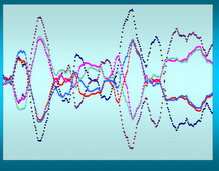The first thing you have to do is generate the pivot points – I showed that calculation to you yesterday. In that post I also mentioned that for swing trading (across several days) I like using the previous week’s high/low/close and for day trading I like to use the previous day’s values. For KKD in this post we are day trading so I generated the pivot points as follows –
R1 – 12.45; MPH – 12.16; PP – 11.86; MPL – 11.70; S1 – 11.54.
The MPH and MPL are simply the midpoint high and midpoint low and are found by finding the midpoints between the PP and R1 and the PP and S1. That’s pretty simple. The MPH and MPL are used as checkpoints on the way up or down. They are used for positioning stop loss. Now look at the following chart – I’ve annotated the appropriate points (as well as I could).

The trade is taken at the pivot point +/- 10 cents. You can see by the red dotted line on the chart that the previous day’s close was about 12.12 so the pivot point is located below that level. When KKD opened it gapped up and then dropped instantly with heavy volume. The next candle showed a higher low so we could probably say that the first drop was just panic-based selling reflecting the market’s opening gyrations and was truly meaningless. Take the trade at 11.94 because if it didn’t drop through the pivot point at this time it probably won’t for awhile. Set your stop at the MPL, which is 11.70, and not shown on the chart for obvious reasons.
Then the trade takes off. Note that when it hits MPH it flattens out and then takes off again from that point. That is expected at the MPH. For the regression-to-the mean guys you can see that the EMA 4 was running far away from the EMA 21 and by the time the price broke over R1 it was pretty well exhausted.
You have two choices here. People who day trade for a living realize that the stock will probably rebound off the EMA 21 (or MA 20) and continue the journey (after all this stock has been going up for a month now). So choice one is sell right after it hits R1 and take your profits and run. Choice two is reset your stop at MPH and wait for the rebound. In this particular stock on this particular day it did rebound but closed right on R1 so either choice would have garnered the same amount.
What if it went through R1 and kept on going? Then you set your stop at R1 and play it to R2 or to wherever it decides to top. Most often however R1 is kind of the limit for a day trade.
One of the nice features of Pivot Points is that they give price a context. You are not always trying to guess the next move because most often the pivot point is controlling the outcome. Isn’t that nice?

1 comment:
Now thats really really good material.
Post a Comment